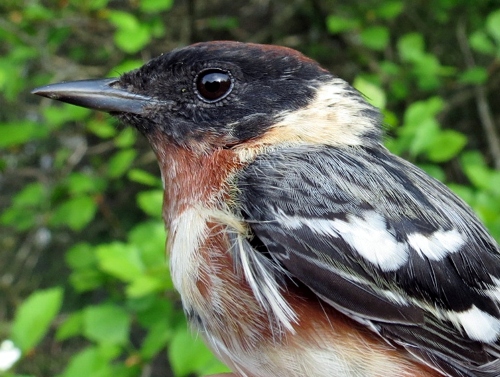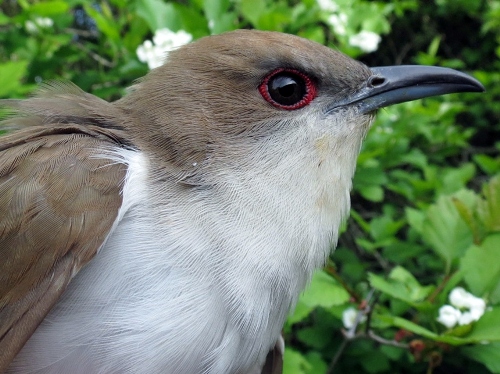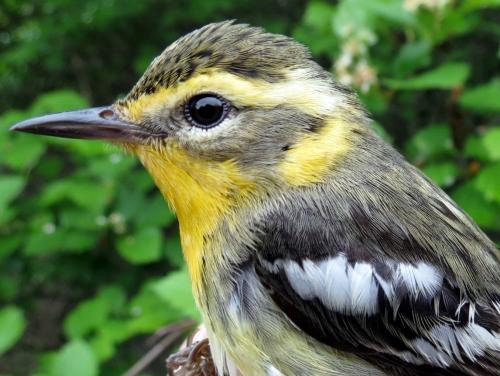|
|
THIS WEEK |
THIS SPRING |
2013 TOTAL |
SITE TOTAL |
|
# birds (and species) banded |
266 (40) |
629 (60) |
997 (65) |
42509 (112) |
# birds (and species) repeat |
54 (16) |
149 (27) |
220 (29) |
8201 (70) |
|
# birds (and species) return |
36 (11) |
90 (23) |
122 (27) |
1331 (38) |
|
# species observed |
95 |
136 |
140 |
208 |
|
# net hours |
482.0 |
2359.0 |
2414.0 |
71703.7 |
|
# birds banded / 100 net hours |
55.2 |
26.7 |
41.3 |
59.3 |
|
|
Note: table does not include nocturnal banding (owls) |
Bander-in-charge: Gay Gruner
Censusers: Nicolas Bernier, Sue Bishop, Salomé Bonnefoi, Cindy Bouchard, Marie-France Boudreault, Emily Boulanger, David Davey, Rui de Jesus, Barbara Frei, Jo-Annie Gagnon, Nathalie Gendron, Alison Hackney, Marie-Anne Hudson, Lisa Keelty, Francine Marcoux, Betsy McFarlane, Lisa Rosenberger, Catherine Russell, Ahmad Shah, Marilou Skelling, Patricia Stotland, Elise Titman, Rodger Titman
Notes: After stalling a bit last week, the migration floodgates opened this week, especially with respect to warblers. The 266 birds banded this week was the second-highest one week total for spring, behind only the 299 this week in 2009. As in 2009, the influx was driven by a top three of Tennessee, Magnolia, and Yellow Warblers. Also in a similar vein, the 60 species banded to this point in spring matches the high posted in 2009 (although also matched in 2012). That includes another 17 species added over the past week: Black-billed Cuckoo, Traill's Flycatchere, Great Crested Flycatcher, Blue-headed Vireo, Warbling Vireo, Gray Catbird, Tennessee Warbler, Magnolia Warbler, Cape May Warbler, Black-throated Green Warbler, Blackburnian Warbler, Bay-creasted Warbler, Black-and-white Warbler, Wilson's Warbler, Canada Warbler, Lincoln's Sparrow, and Rusty Blackbird. The number of species observed also remains well above average, with 136 so far this spring, just behind the record pace of 138 as of week 8 in 2009. This week's 15 additions were Black-billed cuckoo, Chimney Swift, Ruby-throated Hummingbird, Traill's Flycatcher, Red-eyed Vireo, Purle Martin, Wood Thrush, Magnolia Warbler, Blackburnian Warbler, Bay-breasted Warbler, Blackpoll Warbler, Wilson's Warbler, Canada Warbler, Lincoln's Sparrow, and Indigo Bunting.

Also among the less common warblers at MBO is Bay-breasted - this one was only the seventh ever banded here in spring.
(Photo by Gay Gruner)
|
This week’s
top 10 [last week's top 10 in brackets]
#
individuals banded |
mean # individuals observed daily |
1. Magnolia Warbler (51) [-] |
1. Ring-billed Gull (53) [1] |
2. Tennessee Warbler (38) [-] |
2. Red-winged Blackbird (51) [3] |
3. Yellow Warbler (25) [3] |
3. American Crow (27) [4] |
4. Northern Waterthrush (23) [7] |
4. Yellow Warbler (20) [5] |
5. White-crowned Sparrow (14) [-] |
5. Cliff Swallow (15) [-] |
6. Red-winged Blackbird (11) [1] |
5. Baltimore Oriole (15) [-] |
7. Gray Catbird (10) [-] |
7. Common Grackle (14) [8] |
8. Common Yellowthroat (9) [6] |
8. Black-capped Chickadee (12) [8] |
9. Least Flycatcher (8) [10] |
9. Canada Goose (11) [2] |
10. Nashville Warbler (5) [5]
10. Yellow-rumped Warbler (5) [2]
10. Canada Warbler (5) [5]
10. Lincoln's Sparrow (5) [2]
|
10. American Goldfinch (10) [-] |
|
This was the first week this year that Magnolia Warbler was banded - and yet it still managed to take top spot among this week's impressive list of birds banded - and the same goes for Tennessee Warbler in second place. This week's count of Magnolia Warblers was in fact greater than any previous full-season total for the species in spring. Tennessee Warbler actually had a slightly higher count this week last year (42) but both Yellow Warbler in third place and Northern Waterthrush in fourth also set single-week records for spring. Another four warblers cracked the list, thanks in part to a four-way tie for tenth place. The most noteworthy of those was Canada Warbler, not just because it is listed under the Species at Risk Act as Threatened in Canada, but also because only once in 8 previous years have we banded more than 5 in a spring season, so getting that many in one week is significant. The count of 14 White-crowned Sparrows this week was also noteworthy, considering that last year the total for spring was only 8, and the year before just 10. The addition of 8 Least Flycatchers this week brings the spring total to 10, matching the record set in 2008.
Ring-billed Gull remained the top species observed this week, slightly edging out the fairly stable number of Red-winged Blackbirds. As has been the case in every previous year, the last flocks of migratory Canada Geese were seen in week 7, and the numbers dropped significantly in week 8. Correspondingly, American Crow and Yellow Warbler each moved up one rank compared to last week. The mean daily count of Yellow Warblers in the previous 8 years has ranged fairly consistently between 12 and 17 during week 8, so the jump to 20 this year is a surprise. After a couple of years when Cliff Swallows were unusually scarce in mid-May, it was encouraging to see them return to the top five this week. More impressive was the record high daily mean of 15 Baltimore Orioles - a delightful abundance of orange and black everywhere!
|

Overall, this week's rarest bird was the Black-billed Cuckoo above, only the 8th ever banded at MBO, and just the second in spring (photo by Simon Duval). Meanwhile, the next generation of birders got a start at MBO this week - see below (photo by Gay Gruner).

|




